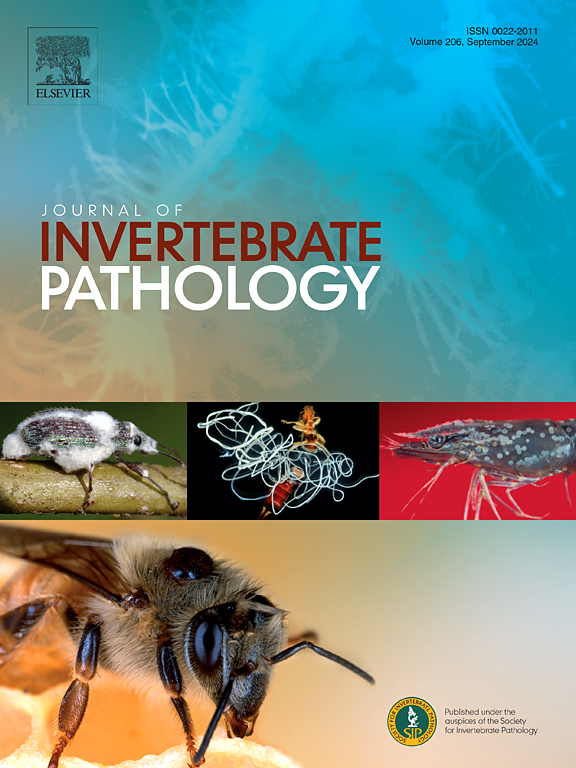黄粉虫商业群体中的新型RNA病毒
IF 2.4
3区 生物学
Q1 ZOOLOGY
引用次数: 0
摘要
以食用和饲料为目的的昆虫大规模饲养正在迅速扩大,以应对当前蛋白质需求的增加。大量饲养的昆虫菌株的特点是与包括病毒在内的微生物相互作用,这种相互作用可能是有益的,也可能是致病的,并可能导致宿主健康的改善或降低。黄粉虫(tenbrio molitor)是一种主要作为食物和饲料饲养的鞘翅目昆虫,对黄粉虫致密病毒(tenbrio molitor densovirus, TmDNV)高度敏感,可导致整个种群在几天内消失。病毒对大规模饲养的黄粉虫的潜在影响突出表明需要筛选与该昆虫物种相关的其他昆虫病毒。在这项研究中,我们描述并鉴定了与一种欧洲商业化的黄粉小步虫毒株相关的5种新型病毒:黄粉小步虫vira -like virus 1 (TmViLV1)、黄粉小步虫vira -like virus 2 (TmViLV2)、黄粉小步虫iflavvirus 1 (TmIV1)、黄粉小步虫tombusvirus 1(有两个片段)(TmToV1)和黄粉小步虫相关narnavvirus 1 (TmAsNaV1)。然后,我们评估了这些病毒在来自世界各地的T. molitor养殖场的T. molitor样本中的流行程度。评估宿主-病毒的相互作用有助于揭示病毒对昆虫发育的影响,并对大规模饲养设施的可能影响提供见解。本文章由计算机程序翻译,如有差异,请以英文原文为准。

Novel RNA viruses in a commercial colony of Tenebrio molitor
Insect mass rearing for food and feed purposes is rapidly expanding in response to the current increase in protein demand. The mass reared insect strains are characterized by interactions with microorganisms, including viruses, that can be either beneficial or pathogenic and might lead to improved or decreased host health. The yellow mealworm, Tenebrio molitor, is a coleopteran species mainly reared for food and feed purposes showing high susceptibility to the Tenebrio molitor densovirus (TmDNV), which can lead to the loss of the entire population in a few days. The potential effect of viruses on mass-reared yellow mealworm highlights the need to screen for additional insect viruses associated with this insect species. In this study, we described and characterized five novel viruses associated with a European commercial T. molitor strain: Tenebrio molitor virga-like virus 1 (TmViLV1), Tenebrio molitor virga-like virus 2 (TmViLV2), Tenebrio molitor iflavirus 1 (TmIV1), Tenebrio molitor tombusvirus 1 (with two segments) (TmToV1), and Tenebrio molitor associated narnavirus 1 (TmAsNaV1). Then, we assessed the prevalence of these viruses in T. molitor samples derived from T. molitor rearings located worldwide. Assessing host-virus interactions aids in unravelling the effect of viruses on insect development, giving insights into possible implications for mass-rearing facilities.
求助全文
通过发布文献求助,成功后即可免费获取论文全文。
去求助
来源期刊
CiteScore
6.10
自引率
5.90%
发文量
94
审稿时长
1 months
期刊介绍:
The Journal of Invertebrate Pathology presents original research articles and notes on the induction and pathogenesis of diseases of invertebrates, including the suppression of diseases in beneficial species, and the use of diseases in controlling undesirable species. In addition, the journal publishes the results of physiological, morphological, genetic, immunological and ecological studies as related to the etiologic agents of diseases of invertebrates.
The Journal of Invertebrate Pathology is the adopted journal of the Society for Invertebrate Pathology, and is available to SIP members at a special reduced price.

 求助内容:
求助内容: 应助结果提醒方式:
应助结果提醒方式:


